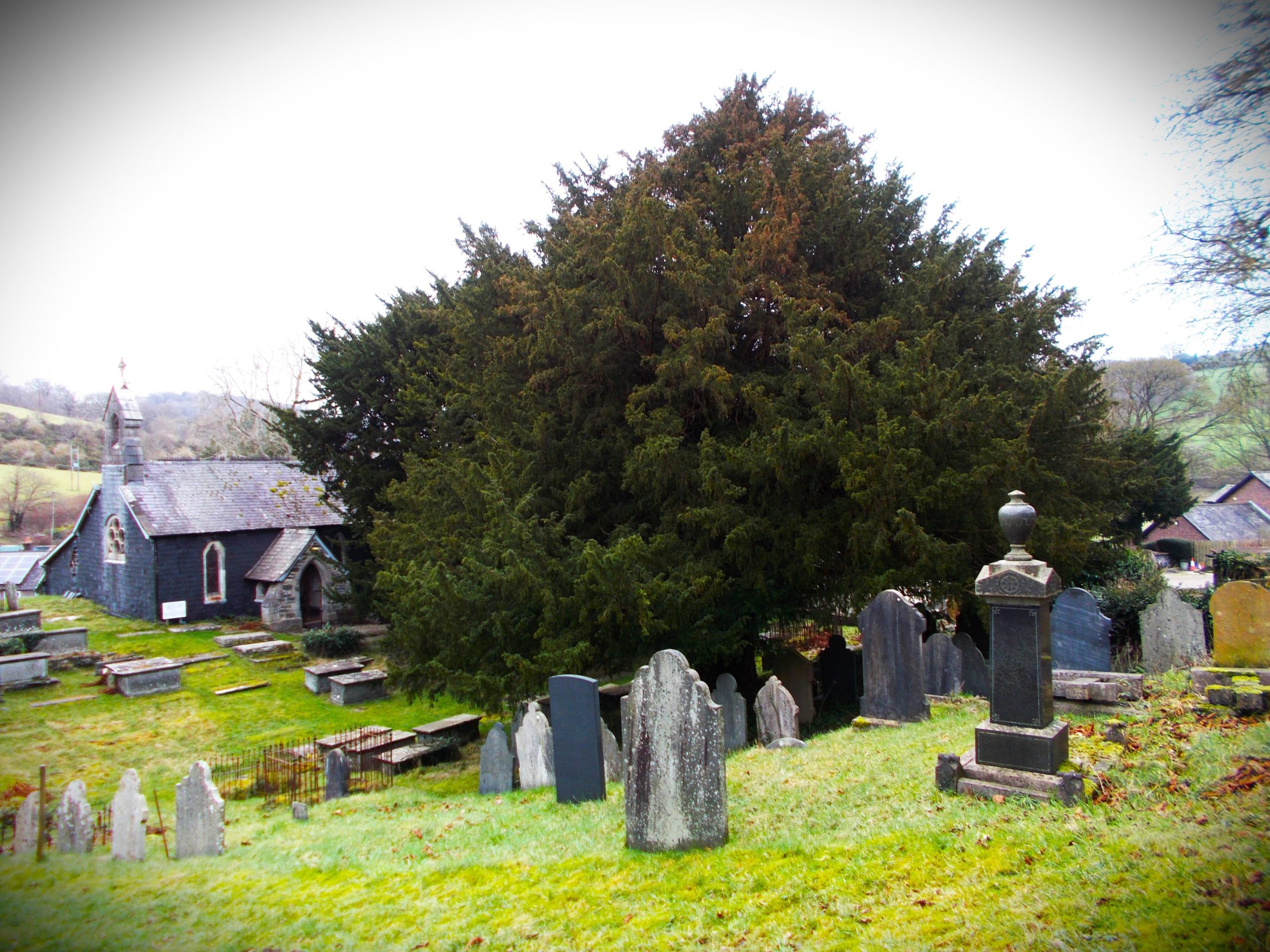The Nantglyn Yew
This our fourth walk from our guest blogger Julie Brominicks the author of The Edge of Cymru. They are all accessible by public transport and each one will have a simple map for you to follow. We have another 4 planned for you over the next few months, so look out for them on our social media channels. We want to inspire you explore our beautiful part of the world that little bit deeper.
Above my head, a flicker of wings between evergreen boughs that filter sunlight the way stained glass windows do. The whistle of a goldcrest and chatter of tits. I am two metres off the ground in the tree but the birds are still so far above me in the crown that to them I’m irrelevant.
With a girth more than seven metres and colossal bushy crown, the Nantglyn Yew is a giant, thriving in the grounds of the church of Sant Iago (St James) which it definitely dwarfs, but only possibly predates, however tempting it might be to presume so. The worship of sacred trees is older than Christianity, and it seems that the first churches may have been built on sites of earlier Pagan worship, but yews are difficult to date. Andrew Morton, in his excellent book ‘Trees of the Celtic Saints; The Ancient Yews of Wales’ explains that the heartwood rots away making carbon-testing and dendrochronology impossible, while typically chaotic growth makes even girth measurements problematic.

It is many years since the heartwood rotted out of this yew but at some point, slate steps and a lectern were skilfully fitted into the hollow, as legend would have it to allow Methodist leader John Wesley to preach from the tree in 1790. An agile person can haul themselves up ‘The Pulpit Yew’ by the handrail, into the tree’s very heart.
So here in the heart I sit. I hear the clatter of pigeons, inhale the evergreen scent. Touch the rosy smooth bark and the small broom-heads of bushy growth. Several mature stems burst straight from the bole – I count at least seven. They give me the impression of being in a forest. The spaces between them reveal views veiled by evergreen fronds; slabs of moss on the slate church roof, the adjourning hill field and its hedges. The ground where a mulch of needles gives to mossy grass, graves and violets. These verdant vignettes, the stream song and fragrance conspire to confuse me. How long have I sat in this church of birds? And that is when it hits me – the enormity of time. I have spared maybe an hour to this tree that has lived, sustained and shaded here for centuries.
Bus
Dinbych has regular services from across the county. The 14 P&O Lloyd Service runs between Dinbych and Yr Wyddgrug (Mold). M&H run the 76 between Dinbych and Rhuthun. Arriva runs the 51 between Rhyl and Dinbych. Note that the 76L (via Llandyrnog) stops right outside St Marcella’s Church, while the other 76 services can be caught just a 2-minute walk from there.
You can reach Nantglyn from Dinbych by 77 Fflecsi bus – it is recommended that you book your journey between one week and one day in advance by downloading the app from fflecsi.wales or calling 0300 234 0300.
For more information about public transport in Sir Ddinbych
Don’t forget that a 1bws ticket for £6.50 gives you unlimited travel in North Cymru on all services.
Walk
The yew and the post-medieval church of Sant Iago (St James) in whose graveyard the yew grows, occupy a peaceful site in the small village of Nantglyn through which a stream sings. This is a 7-mile linear walk, leafy in spring, linking waymarked paths across open country with stiles, lanes and fields which can be muddy and a short stretch by road. I recommend booking a Fflecsi bus from Dinbych to Nantglyn and walking back. That should give you plenty of time to also visit St Marcella’s Church on the Rhuthun Road (which also has yews) and a peaceful ambience, and is open in daylight hours.
- From the church gate turn right, then left at the crossroads and over the bridge. Keep on the road passing woods on your left, then follow the bridleway sign to your left.
- Keep on the bridleway, crossing a stream and onto a hillside and under an oak copse. Follow it between hedges and standing trees uphill to a lane.
- Turn left onto the lane under Foel Gesych then almost immediately left onto Clifford Byway.
- Follow the byway downhill, on a green scoop of a lane, then leave it to turn right onto a green lane between trees. It will take you down past a house onto a lane – follow the lane to the road.
- Turn right on the road, rising slightly. A short way along look for footpath signs left. Follow the waymarks leading you down fields, then right along a stream which you cross by bridge – avoiding the hole!
- Keep following the waymarked signs across the fields, keeping the wooded stream banks in sight down to your right.
- Eventually the waymarks lead you into the woods and along the stream. You are now on private land, the path is a little slippery but well indicated by signs on trees. When emerging at a new footbridge do not cross it. Keep on left bank of stream, following signs to woodland then up field left along the fenceline to join track.
- Turn right onto track and follow it around the quarry and walled garden of private house.
- Keep following the waymarked paths along fields till it joins Taith Clwyd – the Clwydian Way.
- You can cut into Dinbych sooner if short on time. Otherwise stick to the well-marked Taith Clywd across fields south of Dinbych, till reaching Brookhouse Farm. From here take the path north and across the road to St Marcella’s Church and yew trees – and enjoy the peace.

